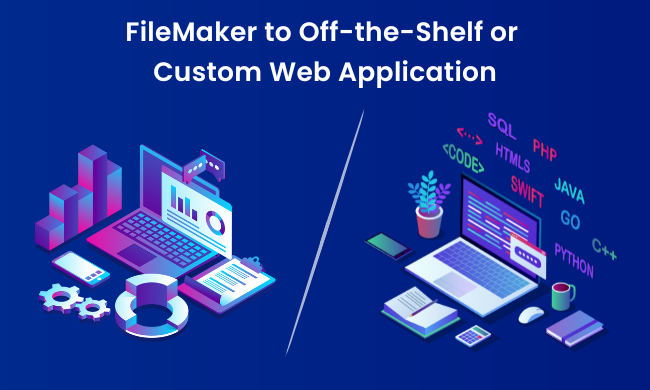
Introduction:
When considering the future of your FileMaker solution, you have two primary options: converting to an off-the-shelf program like Zoho, HubSpot, Salesforce, or similar platforms or investing in a custom web application solution. In this article, we’ll explore the benefits and processes involved in both conversion paths, helping you make an informed decision for your business.
Converting to Off-the-Shelf Programs:
Benefits of Off-the-Shelf Programs:
- Robust feature sets that cater to various business needs.
- Scalability and flexibility to accommodate growth.
- Integration capabilities for seamless connectivity with other systems.
- Vendor support and updates for ongoing system maintenance.
- Time and cost efficiency compared to custom development.
- User-friendly interfaces and extensive training resources for quick adoption.
Conversion Process:
- Assess Business Needs: Evaluate your requirements and compare them with the features offered by off-the-shelf programs. Identify which platform aligns best with your business goals and processes.
- Data Migration: Extract data from your FileMaker solution and convert it into a format compatible with the chosen off-the-shelf program. This may involve data mapping, cleansing, and transformation to ensure a smooth transition.
- Configuration and Customization: Set up the off-the-shelf program based on your specific requirements. Configure modules, workflows, and user permissions to align with your business processes. Customize the system within the limitations of the platform, utilizing available options for tailored functionality.
- Integration: Connect the off-the-shelf program with other systems used in your business. Utilize provided integration options or third-party tools to establish seamless data flow and interoperability.
- User Training and Adoption: Provide training sessions and resources to familiarize your team with the new system. Ensure proper onboarding and support during the transition period to encourage user adoption.
Converting to Custom Web Application:
Benefits of Custom Programming:
- Tailored solutions that precisely match your unique business requirements.
- Complete control over features, workflows, and user interfaces.
- Ability to accommodate complex business processes and specific industry needs.
- Flexibility for future enhancements and scalability as your business evolves.
- Ability to integrate with legacy systems
- Ability to build custom reporting
Conversion Process:
- Requirement Gathering and Analysis: Collaborate with stakeholders to identify and document specific business requirements and desired functionalities. Analyze existing FileMaker solution to determine conversion scope.
- System Design and Architecture: Develop a comprehensive system design that outlines the structure, components, and interactions of the custom program. Consider scalability, performance, security, and future expansion.
- Storyboarding: Building a detailed storyboard on how the system would function with every step and process shown in a graphical format to clarify every need and risk in the program.
- Development and Testing: Implement the custom program based on the defined design. Develop required features, databases, user interfaces, and integrations. Thoroughly test the solution to ensure functionality, usability, and data integrity.
- Data Migration and Integration: Migrate data from the FileMaker solution to the custom program. Establish integrations with other systems or databases as necessary, ensuring smooth data flow and synchronization.
- User Acceptance Testing and Training: Engage users in acceptance testing to validate the custom program against requirements. Conduct training sessions to familiarize users with the new system and its functionalities.
- Deployment and Support: Deploy the custom program in the production environment. Provide ongoing support, maintenance, and updates to address any issues and ensure optimal performance.
Conclusion:
When converting FileMaker, the choice between off-the-shelf programs or custom programming depends on your specific business needs. Off-the-shelf programs offer ready-made solutions with extensive features, support, and integration capabilities. Custom programming, on the other hand, provides tailored solutions and full control over functionality. Assess your requirements, consider the conversion processes involved, and choose the path that aligns best with your business goals, resources, and long-term vision.
